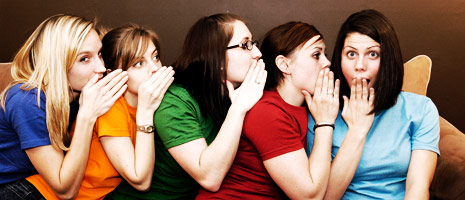
Source: Young Go Getter
Over the years, I’ve had the opportunity to work with “Viral Marketing Scientist” Dan Zarrella on special projects related to Twitter. His focus on social science and psychology as it relates to new media and online interaction and behavior is in line with my philosophy and approach to understanding and documenting socialized media.
Zarrella recently debuted TweetPsych, a sophisticated system that uses two linguistic analysis algorithms (RID and LIWC) to build a psychological profile of a person based on the content of their tweets. He also adapted the service to analyze a site URL and the content on that page to create a list of the 50 Twitter users who’s profiles are psychologically aligned with the site you provided. It’s a fascinating service for those actively seeking to expand their contextual networks.
One of the most actively discussed aspects of Twitter is the art and science of retweets. Retweets, in my opinion, are one of the most sincere forms of recognition and validation, empowering users to pay it forward through the recognition of noteworthy content. According to Dan, retweets also serve as the foundation for assessing the qualities of viral content, “You don’t spread ideas just because they are “good;” you spread them because of some other trigger or set of triggers has been pulled in your brain. We can now compare millions of viral ideas to uncover the building blocks of contagiousness.”
Aside from my very simple advice to leave room in your tweets for people to add RT and their username, “120 is the new 140” and to also tweet something worth retweeting, Zarrella studied the science of retweets over a period of nine months to discern the attributes and characteristics of tweets that spawned memes and those that didn’t. His sampling group was not insignificant either. He analyzed roughly five million tweets and 40 million retweets to discover the art and science of getting retweeted.
He published the results in a 22-page report, which you can download here.
Zarrella’s initial finding estimated that 1.44% of all tweets are ReTweets. From there, he recognized other important common traits for successfully getting retweeted.
Links are the Currency of Twitter
According to Zarrella, links were three times more prevalent in RTs over normal tweets, 19% to 57%.
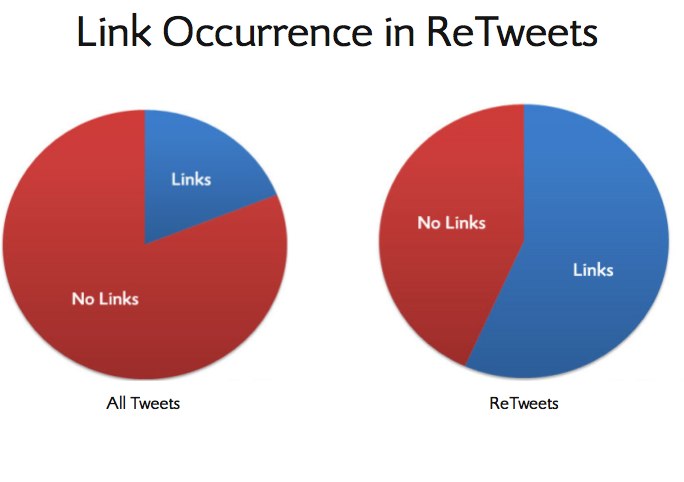
The study also found that the URL shortener used also had an effect on the potential resonance of tweets. For example, bit.ly, ow.ly, and is.gd, were much likelier to get retweeted than older, longer services, such as TinyURL.
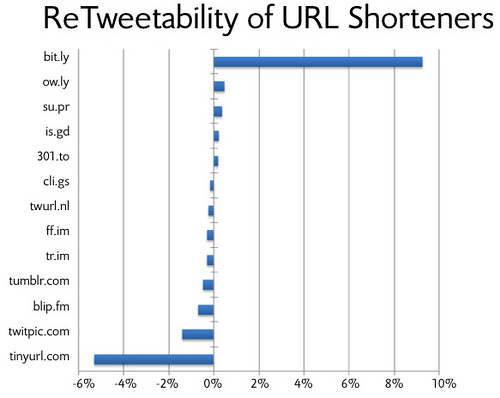
Choosing Words Carefully
Pandering or soliciting for retweets might seem tacky, but asking politely for a retweet actually works according to the research.
The top 20 retweetable words and phrases include:
1. You
2. Twitter
3. Please
4. Retweet
5. Post
6. Blog
7. Social
8. Free
9. Media (note, most likely tied to social media, which demonstrates the interest in related tweets and links)
10. Help
11. Please Retweet (personally i’ve found that adding “please share” or “pls share” to the tweet helps as well)
12. Great
13. Social Media
14. 10 (The blogosphere and Twitterverse share significant interest in anything with a “top 10” list
15. Follow
16. How to
17. Top
18. Blog post
19. Check out (a call to action indeed inspires action and traffic)
20. New blog post
Chatter isn’t Worth Sharing
As I’ve shared numerous times, literally answering Twitter’s question of “What are you doing” engenders uninteresting tweets. The research found that verbs ending in “ing”were among the least retweetable words. Although, I’ve personally found in my research that “reading,” “reviewing,” and “looking” trigger significant activity. People generally want to know what has your attention at the moment and if they can look at something through your eyes, it helps spark retweets and clickthroughs.
The least retweetable words:
1. Game
2. Going
3. Haha
4. lol
5. But
6. Watching
7. Work
8. Home
9. Night
10. Bed
11. Well
12. Sleep
13. Gonna
14. Hey
15. Tomorrow
16. Tired
17. Some
18. Back
19. Bored
20. Listening
Don’t take intelligence for granted
While many suspect that simple language is preferred, retweets contained an average of 1.62 syllables per word with normal tweets boasting an average of 1.58 syllables per word. It may seem insignificant, but per a Flesch-Kincaid test, comprehending RTs required 6.47 years of education, while normal tweets require just 6.04.
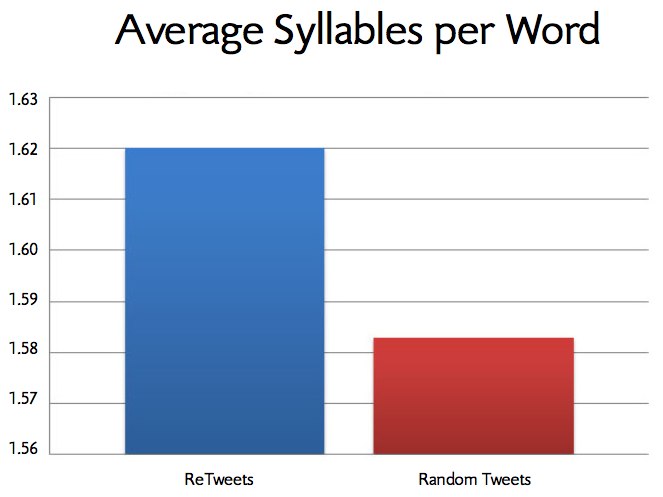
The Novelty of Novelty
One of the most interesting aspects of viral content is its freshness, insinuating that the newness of the content was a significant factor in RTs. For example, Zarrella created a measure of novelty by counting how many times each word in his sample sets occurred. In random tweets, each word was found an average of 89.19 times, while in the ReTweet sample each word was only found 16.37 other times.
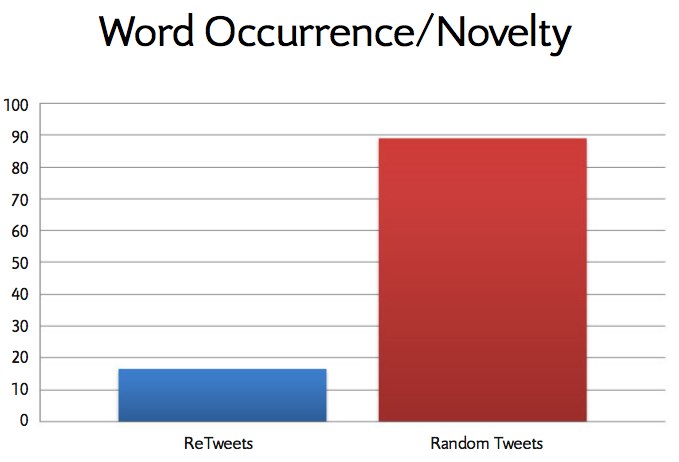
It’s Not Just a Figure of Speech
The analysis of words indicated that nouns and third-person singular present words led to the proliferation of headline style tweets that triggered retweets. The pervasiveness of verbs and proper nouns were also factors. To observe this activity, Zarrella used Part of Speech (POS) tagging, an analysis technique in which an algorithm is used to label each word in a piece of content as a specific part-of-speech–noun, verb, adjective, etc.
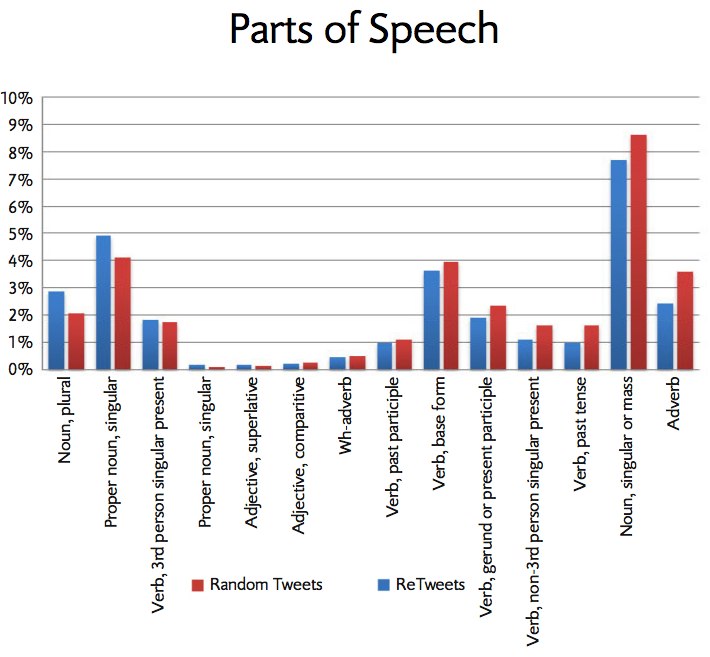
The Power of Punctuation
The power of punctuation isn’t necessarily relegated to grammar or sentence structure. The use of punctuation could also represent the difference between a tweet and a retweet. 85.86% of normal tweets contained some form of punctuation compared to 97.55% in retweets with colons leading the way.

Of the most common punctuation types found in retweets, colons, periods, exlamation points, commas, and hyphens led group with semicolons ranking last. In fact, Zarrella observed that the semicolon appears to be the “only unretweetable punctuation mark.” What’s interesting however, is that the question mark ranked second-to-last. I would have guessed that questions would have been more prominent in RTs, but after further thought, I would imagine the any tweet containing a question would trigger more answers than the RT of the original question.
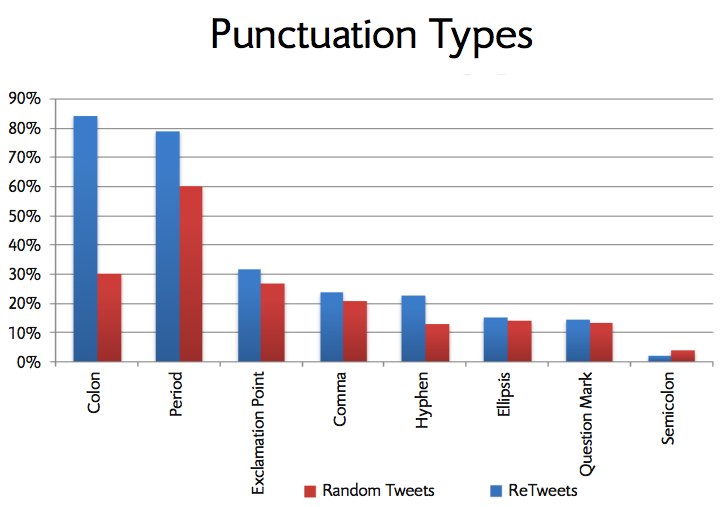
There is no “I” in ReTweet or Tweet
LIWC measures the cognitive and emotional properties of people based on the words they use. Applying this lexicon to tweets and retweets, LIWC analysis shows that Tweets about work, religion, money and media/celebrities are significantly more retweetable than tweets with negative emotions, sensations,
swear words and self-reference.
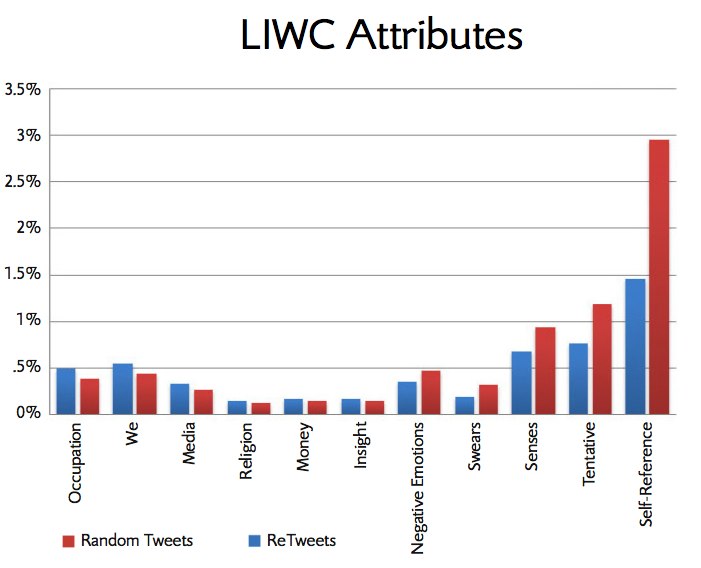
The Attention Aperture: Time and Day Count for Everything
I have also studied the time/day significance applied to what I call the attention aperture (the state of attention and its ability to be captured). I believe that the results vary depending on the nature of the content, specific to whether or not the nature of the Tweet was professional or personal in nature.
Among the most usable findings from Zarrella’s study is the analysis of when individuals appear to be more susceptible to retweeting. According to the research, the window for retweets is at its widest between 2 p.m. to 11:59 p.m. (however, I’d like to know if time zone played a factor in RTs). Match the time to the most active days for retweeting, in this case Thursday and Friday, and surely, we have identified the attention aperture for RTs.
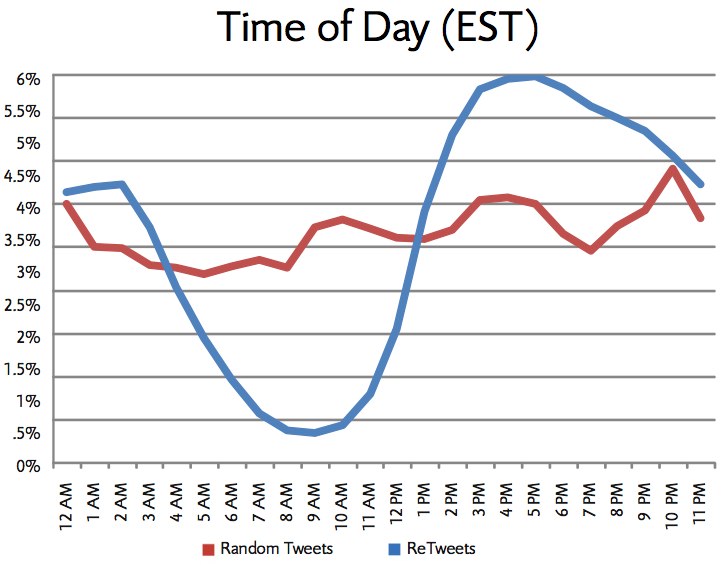
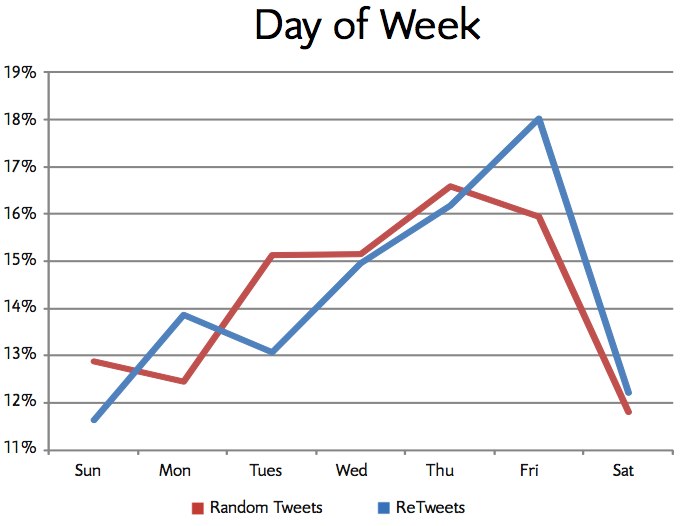
In my research, I found that educational, news-focused, or work-related tweets found its greatest traction between 3 a.m. and 9 a.m. Pacific time. I suspect that this range casts a wider net reaching professionals during work hours with the East Coast and Europe prompting RTs that bring it back to the attention of those on the West Coast as individuals prepare or arrive at work. As such, I asked Dan to create a new graphic that visualizes days and times in a way that might be easier to reference.
This study was as fascinating as it was informative. But I needed a personal touch to close close the chapter and remind us that there are real people behind the data and the tweets that were analyzed. I asked Dan to share what he learned from his research, and he readily obliged, “My favorite takeaway from the data is that while having more followers definitely makes it easier to get more ReTweets, even if you don’t have tens of thousands, the data shows that if your content is contagious enough, it will spread just as far. I think this also has to do with the hyper-connected, seven degrees nature of the Twitter network.”
In the end, as publishers, it is our responsibility to ensure that our Tweets not only speak for themselves, but also represent our purpose, mission, and values. While this data suggests that the mechanics for posting viral tweets is a matter of formula, I believe that affinity, respect, and stature also play prominent roles in the art and science of retweeting. Concurrently it is also our obligation to also retweet as a form of giving back to the community, recognizing those who actively contribute to a more meaning Twitterverse.
Connect with Brian Solis on:
Twitter, FriendFeed, LinkedIn, Tumblr, Plaxo, Plurk, Identi.ca,BackType, Posterous, or Facebook
—
Have you bought the book or the poster yet? (click below to purchase):
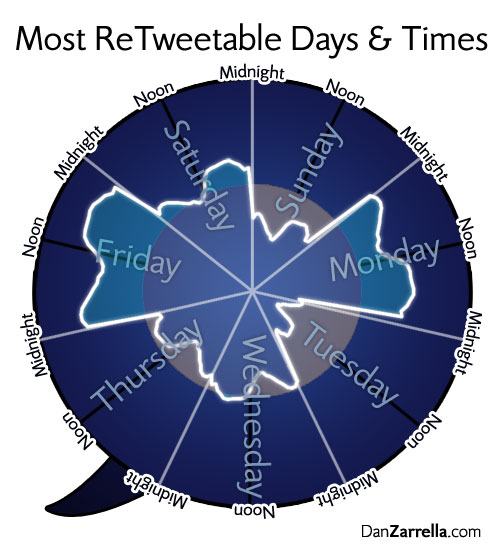



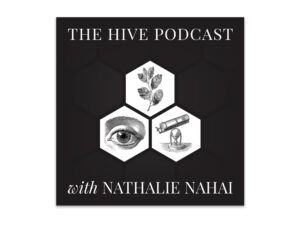



Great numbers. The time of day and day of week charts for Twitter are interesting in that they seem to mimic the general trends of site visit data: Friday afternoons seem to be when everyone has time to read/watch/tweet/post. The weekends are for other things. With only 20% of companies encouraging employees to use social media at work (PRWeek study http://www.ciozone.com/index.php/Social-Network…) it would be interesting to see where the Tweeting is taking place.
Thanks Jeff. Interesting feedback…mobile plays a big factor in this as well…
I am a little surprised at the time of day numbers. In my experience living in EST, I get the most RT's between about 7-10am, when people are getting ready for work, or just arriving at work. My magic time for “breaking new thing I just wrote) is about 8:30am.
Wow. This is some awesome info Brian. I'll need to read it again when I can really look into it more, but I appreciate you putting info like this out there for us.
Thanks Michael!
This is AMAZING! Thank you for sharing! GREAT job!
Thanks for sharing such a deep and detailed look at Twitter, Brian. Amazing stuff.
I really like Dan's takeaway from all this… how invaluable it is to have contagious content. The whole notion that content is king still reigns.
And for those of us with hundreds of followers vs. thousands, it's a bit reassuring to know our voice, our ideas, our insights still have a chance of getting through to others beyond our network tentacles. Our primary emphasis remains on producing quality content, on making the substance of our contributions high quality.
This is amazing! Love the information here.
This Site is BRILLIANT
“Please RT” really does work.
Indeed! Hey, btw, did you talk to Gina by any chance?
Very true! If someone says “please RT” I automatically switch off. They also put themselves in danger of being unfollowed if it's persistant self promotion.
Valuable information and data in here that goes beyond speculation or personal opinions/biases. Kudos to Dan Zarella for the science and to you, Brian, for this post.
As for your request: Please RT? In this case, gladly!! And, thanks for leaving room for us followers to add our comments, too! 🙂
Great info for us analytical types!!! Thanks for sharing. Mind if I RT? 🙂
This is a great article. Nice research and communication. Thanks.
Dan Zarella's analysis about retweets shows how Twitter impacts peoples opinions. Its interesting how “RT” has evolved itself as a citation for credibility. Retweets show how people value others opinions as they forward the information to people they know. I think its interesting how people retweet about relative topics such as news, work, religion and money instead of their own self-interest. This evidence shows how much people are impacted by social networking.
Indeed…I'd also like to see how many people who RT a link actually read the content before sharing it…
I got burned on a few retweets I shared too quickly where the link content wasn't what I thought or even where I didn't agree with it at all! now I make a point of re-ading before I re-tweet…
Time zone probably plays a role. More than 70% of tweets are from North America.
A division in continents or even countries will provide different pictures.
For example: South Africans are not retweeters and only 3-4% of South African tweets are read by South Africans. Most responsive words (retweets) for South Africans are 'bokkie', 'hardegat', 'bakgat' and 'gatvol'. In Europe you willl see that relativily most retweeters are based in UK. Etc. etc.
But still: interesting
How genned up are you on the Science of ReTweets?! Check out what @briansolis has to say!
This is a keeper. Retweeting is an integral part of the Twitter experience.
very great analysis of retweet
Excellent blog! I'll definitely RT. 🙂
Wow! Thanks for breaking down all that info, very informative post!
One needs to be very cautious about the data suggesting that “please retweet” and the like get you more re-tweets. It is possible that regular use of “please retweet” could have a negative impact on the number of your followers as well. It's really important to focus on what your goal of a re-tweet would be in advance of strategizing about how to get it retweeted.
In terms of trying to understand Twitter as a terse communications form, I'm really interested in the tweets that get re-tweeted without having links embedded. Those would be the best examples of powerful ideas being expressed within the limited space.
Again re: caution about the research. It might be easier to get re-tweeted via including a link. But your tweets that get re-tweeted without having a link in them might have a bigger impact on developing your Twitter brand.
Now that's what I call a post Brian, I didn't know Monday and Friday was the best RT days, I thought it was on the weekends when people are off from work, thanks for the testing.
I found this post interesting. All the different statistics that show what people retweet is significant. I was surprised that self-reference was not one of the highest retweetable emotional and cognitive factors. I would think that when people read a tweet about themselves they would acknowledge the person who tweeted about them by retweeting their statement. I found it interesting that many of the words listed on the “Least retweetable words” list were “boring” or everyday, normal activities such as, work, sleep, bed and tired. The reason for this could be that people retweet things that are new or interesting not things that happen everyday and our just part of a person’s normal routine. Friday was the most retweeted day and the day that people twitted the most on. I was not surprised by this because I would think people would tend to like to tweet about what they are doing on the weekend and people would be more likely to retweet someone’s tweet on Friday because it is most likely something new, and newness content is retweeted more than average, everyday content.
I understand the middle of the night “wow this is awesome gotta share” retweets, but the end of the work day ones surprises me.
+ Also just a heads up on short urls… http://www.idek.net is a short url that lets you tracks clicks… pretty sweet. It’s fairly new, so I’m not surprised it hasn’t make the cut yet.
I appreciated all of the information in this post. I do a lot of RT'ing and have studied for myself which Tweets I'm more likely to RT. I think that the most relevant advice you gave to people who want to attract RT's is to make a Tweet less than 140 characters from the beginning. If I have to think a lot about which of your precious characters to leave out in order to RT, I'm more likely to move on to the next Tweet. There's just too much good information out there to waste my time.
Thanks so much for passing this along Dan. I’ve been looking for concrete Twitter stats and info and this definitely seems like a great lead. Do you happen to know of any sites that deliver stats on clickthrough rates for Facebook and Twitter? I’ve found sites that claim average Twitter clickthroughs to be anywhere from .1%-4%.Managed hosting
Aprenda como gerar retweets no Twitter
Aprenda a gerar retweets no seu twitter
Great post – great numbers – great analysis. Thank you!
Great post – great numbers – great analysis. Thank you!
Great post. One of the things that caught my attention was the analysis of the URL shortening. In my opinion the only reason that bit.ly is way ahead of the rest is because it has been annointed by Twitter as the default URL shortener and most people don't bother changing it. Tools like TweetDeck also have it as default, so really I don't think it's too valid to say that by using Bit.ly you increase your chances of an RT
I read “The Science of Retweets on Twitter” and really appreciate the useful information I obtained. It is time to tweek those Twitter Centric Marketing campaigns. It will be interesting to see the extent of improvement in retweets. I am certain the ideas in the article will be a big value add to our marketing efforts.
Ron aka LANWANMAN, Ocala, Florida USA
I read “The Science of Retweets on Twitter” and really appreciate the useful information I obtained. It is time to tweek those Twitter Centric Marketing campaigns. It will be interesting to see the extent of improvement in retweets. I am certain the ideas in the article will be a big value add to our marketing efforts.
Ron aka LANWANMAN, Ocala, Florida USA
This is really very useful information. Thank you are sharing the research findings.
Thanks for sharing the research finding. it is very useful
Hmmm, Great post, but I don't understand that last circular graph. What do the colors in it stand for? And from the looks of it Friday and Monday are the most retweetable days, whereas I thought you said Thursdays and Fridays. Oh, also, would you put the Please Retweet or Please Share at the beginning of the tweet or the end or does it matter? Thanks! 🙂
Another homerun post Brian, thanks.
Noteworthy content ! Brian, thanks.
Interesting to see Retweet activity occurs when I was least expecting it ie late afternoon and through the evening and on Thursday and Friday. I need to change the time I tweet from mid morning Tuesday to Thursday and start tweeting mid afternoon with more on a Thursday/Friday.
Thank you for sharing this – really useful
David